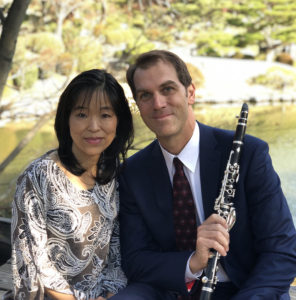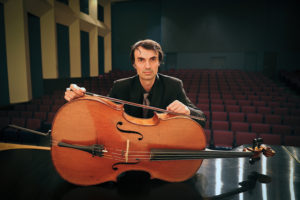SFA music faculty members Christopher Ayer, professor of clarinet, and Evgeni Raychev, cello adjunct faculty, will perform alongside Kae Hosoda-Ayer, associate professor of piano and director of collaborative piano at Baylor University.
The program includes Ludwig van Beethoven’s Trio, op. 38; Max Bruch’s Eight Pieces for Clarinet, Viola and Piano, op. 83; and Johannes Brahms’ Trio, op. 114.
“We chose the program because we are all familiar with these wonderful chamber works, and we have performed them before,” Ayer said. “This allows us to reduce our rehearsal time and possible exposure to the coronavirus.
“While there will be some socially distanced music students in attendance, the recital will not be open to the general public and will be livestreamed instead,” he added. “We simply miss performing chamber music together, and we want to provide our students with an opportunity to attend a live recital featuring standard pieces they should all know.”
The Beethoven piece to be performed is actually an arrangement of his popular Septet, op. 20 from 1800. Possibly modeled after a Mozart divertimento (K. 334), it is in more of a classical style and was a very popular composition immediately after he wrote it, according to Ayer.
“It was so popular that it was arranged for many different instrument combinations, but Beethoven himself did this arrangement for clarinet, cello and piano in 1803 as his op. 38 and dedicated it to the doctor who was attempting to help him with his oncoming deafness,” Ayer said.
For the Bruch work, Raychev will play the viola part on cello.
“The first time I heard the Eight Pieces for clarinet trio by Max Bruch was back in grad school,” Raychev said. “No matter how many times I heard that piece subsequently, whether it was as original, or in arrangements with sax, or cello, or even with a violin, the only memory that keeps predominating was one evening when Frank Kowalsky, Lubomir Georgiev and Carolyn Bridger played it in Opperman Hall at Florida State University. At the time, I thought that it was one of the most beautifully written pieces of chamber music, and that evening I was convinced in the power of the blend between clarinet and cello.”Concluding the program will be the famous Brahms work, written late in his life (1891) when he thought he was done composing. But after hearing a wonderful clarinetist in an orchestra he was conducting at a festival, Brahms quickly composed the Trio, op. 114; the Clarinet Quintet, op. 115; and two Sonatas for clarinet and piano, op. 120.
“This trio is like a Brahms symphony in miniature with all of the drama, rhythmic vitality and beautiful melodies packed into a 23-minute piece,” Ayer said.
For additional information, contact the School of Music at (936) 468-4602.





